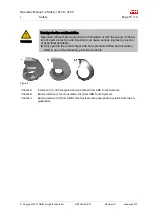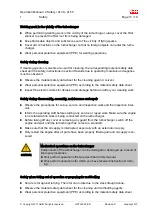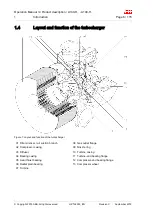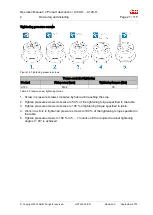
Operation Manual / 4 Product description / A130-H.. - A140-H..
1
Introduction
Page 7 / 115
© Copyright 2015 ABB. All rights reserved.
HZTL4030_EN
Revision C
September 2015
Mode of operation
The turbocharger is a turbomachine and consists of the following main components:
Turbine
Compressor.
These components are installed on a common shaft and form the rotor (see Figure
The exhaust gases of the internal combustion engine flow through the turbine casing (10) and
the nozzle ring (09) onto the turbine (07). The turbine (07) uses the energy contained in the
exhaust gas to drive the rotor and, hence, the compressor wheel (13). The exhaust gases
then reach the atmosphere through the exhaust gas pipe connected to the gas outlet flange
(08).
The compressor wheel (13) sucks fresh air through the air suction branch or the filter silencer
(01). In the compressor wheel (13), the energy required for building up the pressure is
transferred to the air. By flowing through the diffuser (03) and the compressor casing (02), the
air is compressed further and is then directed to the engine cylinders.
The rotor runs in two radial plain bearings (06) which are located in the bearing casing (04)
between compressor and turbine. The axial thrust bearing (05) is located between the two
radial plain bearings.
The plain bearings are connected to a central lubricating oil duct which is normally supplied by
the lubricating oil circuit of the engine. The oil outlet always lies at the deepest point of the
bearing casing (04).
Turbocharger version with compressor wheel cooling
Figure 2: Compressor wheel cooling
Depending on the application of an A100 radial turbocharger, the turbocharger is equipped
with compressor wheel cooling. With compressor wheel cooling, after the compressor air has
cooled down by passing through the charge air cooler on the engine side, it is supplied to the
turbocharger for cooling the compressor wheel. Cooling of the compressor wheel is
compulsory to ensure the reliability and replacement intervals for the relevant operating
conditions. In the turbocharger version with compressor wheel cooling, the cooling air is
supplied through a lateral connection in the bearing casing (01).
In addition, the turbocharger version with compressor wheel cooling is indicated by the
turbocharger type (H6..) on the rating plate.
















































